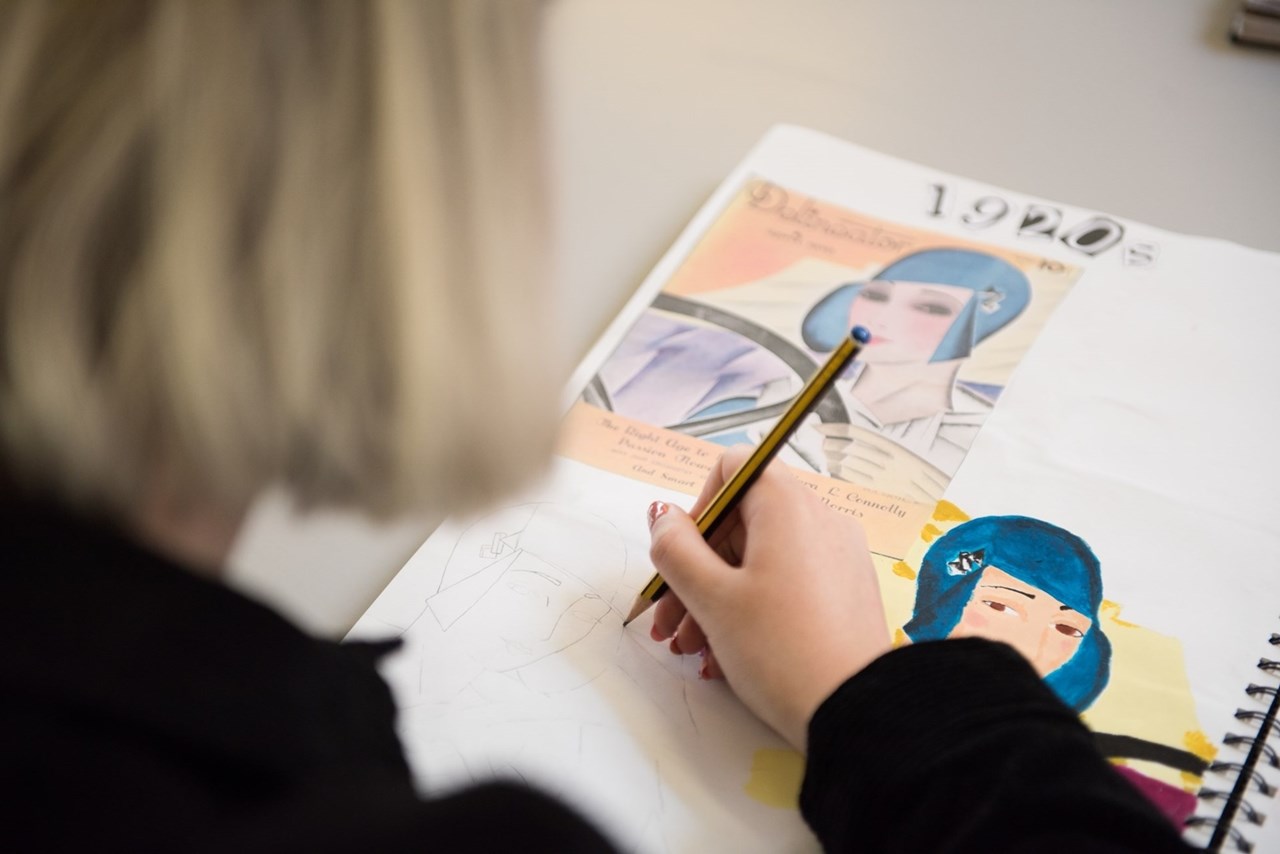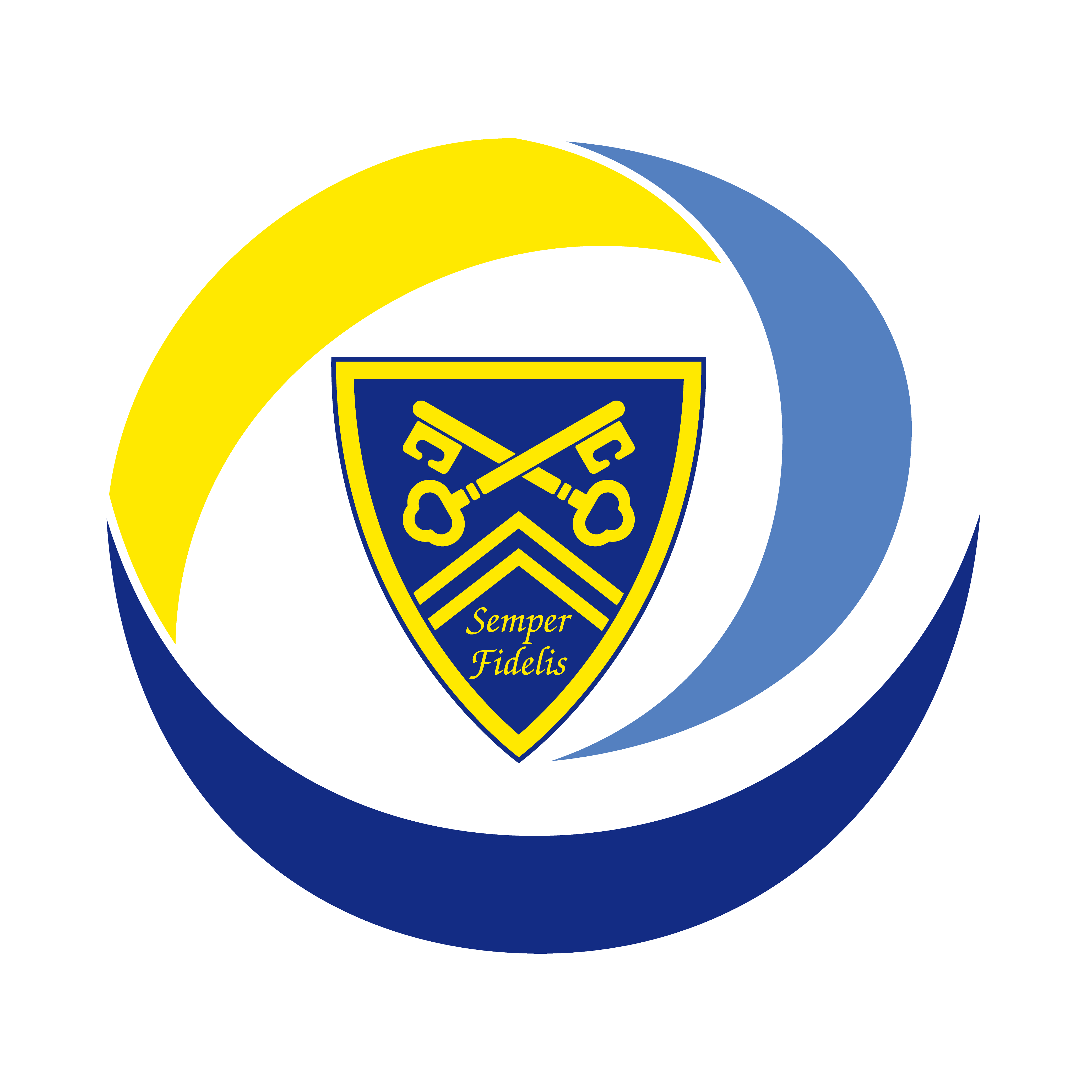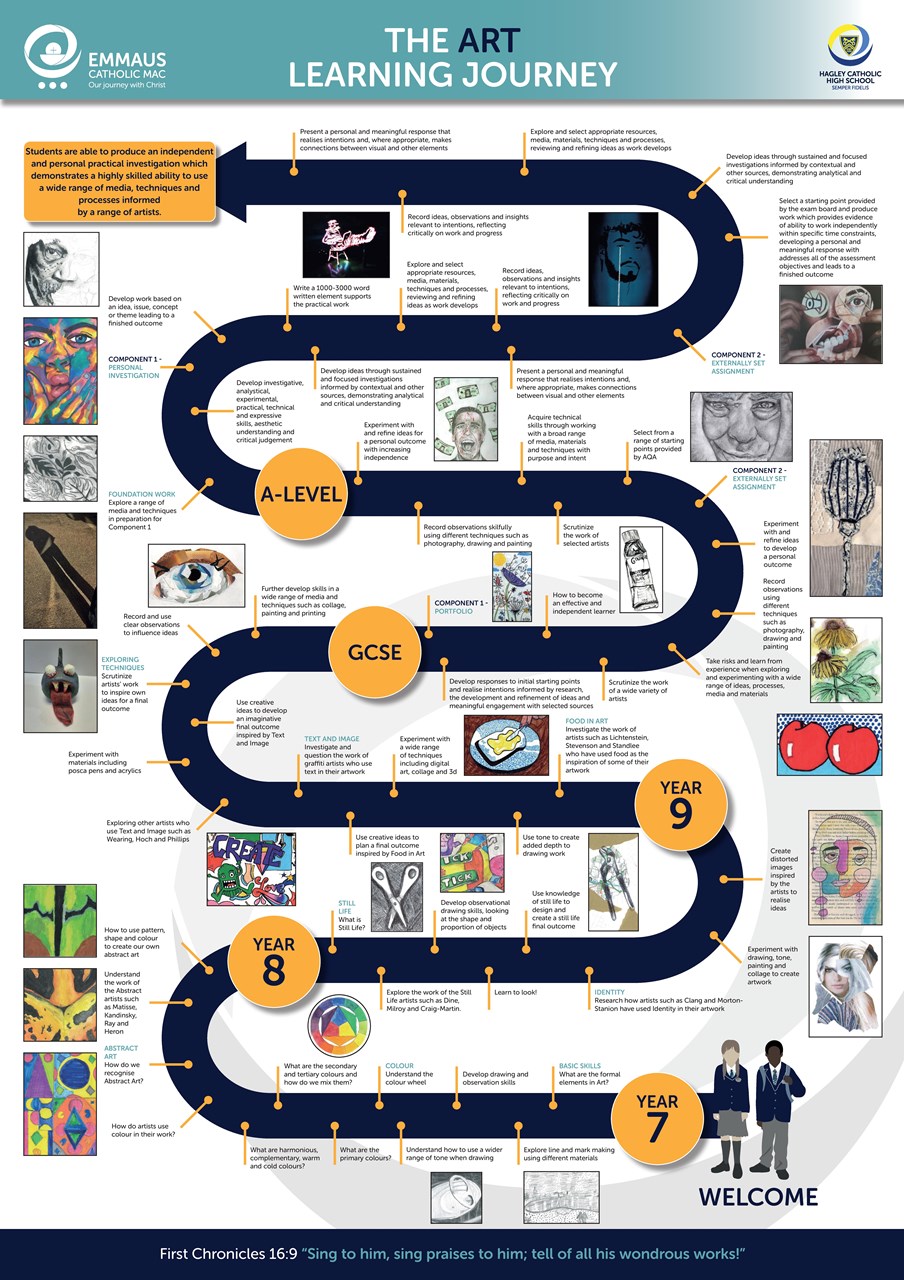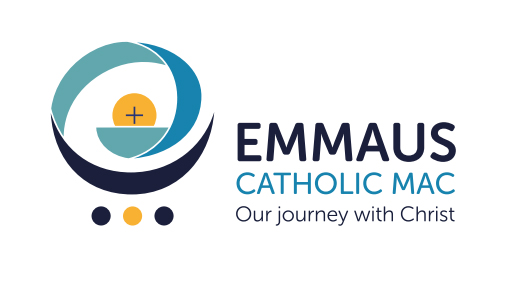Our Art & Design Department
All students at Hagley Catholic High School follow a taught course of Art & Design. The Department is made up by two specialist teachers who are fully committed to the education of the pupils:
Mrs N Stott - Subject Leader of Art & Design - nstott@emmausmac.com
Mrs M O'Loughin - Teacher of Art & Design, Coordinator of School Voice - moloughlin@emmausmac.com
To view the curriculum mapping document and the 'learning journey' poster for Art & Design, then please click on the links below. If you have any queries then please contact the Subject Leader.
Subject Overview
Year 7
PROJECT 1
Basic Drawing Skills:
Pupils are taught about Line, Tone, and Blending etc. through a range of activities. Pupils are introduced to artists who have used these techniques in their work, e.g. Van Gogh. Pupils are assessed on their ability to use tone.
Colour Theory:
Pupils are introduced to colour through a range of activities. They learn about colour mixing and the colour wheel, and use a range of media. They will then have the opportunity to put their knowledge of colour into practice.
Pupils are then assessed at the end of this Unit.
PROJECT 2
Abstraction:
Pupils study the work of Abstract artists such as Matisse, and produce research on the artists. Pupils then use this research to develop their own abstract work using media such as collage and paint.
During the year, pupils will be assessed by…
Baseline Assessment at the start of Year 7 (This takes place in the first two lessons).
Pupils receive a tonal drawing and colour assessment at the end of project 1.
Pupils’ progress will be assessed at the end of each unit; this is based on the four areas; Critical understanding, refining work, recording ideas and presenting a final outcome.
At the end of the year, pupils will be assessed by…
At the end of Project 2 pupils will receive an assessment based on the four areas; Critical understanding, refining work, recording ideas and presenting a final outcome.

Year 8
PROJECT 1
Still Life/Observation:
This Unit of work continues to develop pupil’s observational drawing skills.Pupils arrange objects looking at composition, sketching, shading, proportion, shape etc. Pupils have the opportunity to produce research into various still life artists, and produce a final piece based on their research and observations.
PROJECT 2
Pop Art:
Pupils have the opportunity to produce research into various Pop Artists. Pupils develop their observational, creative and colour skills. Pupils then develop a final piece based on this research.
PROJECT 3
Skills Based:
Pupils will study a range of different skills linking to a range of different artists. Pupils will set success criteria and take part in a number of peer and self -assessment activities.
During the year, pupils will be assessed by…
Pupils will be assessed at the end of each project; this is based on the four areas; Critical understanding, refining work, recording ideas and presenting a final outcome.
At the end of the year, pupils will be assessed by…
Autumn Term
At the end of Project 3 pupils will receive an assessment based on the four areas; Critical understanding, refining work, recording ideas and presenting a final outcome.
Year 9
Cultures:
Pupils produce research on work from another culture (e.g. Thai masks, African Masks, Aboriginal Art, Japanese Art). Based on this research, pupils produce a 3D or mixed media final piece.
Spring Term
Image and Text:
Pupils look at image and text from various sources. This could include CD’s, illustration, design work or looking at political issues and artists such as Barbara Kruger.
During the year, pupils will be assessed by…
Pupils will be assessed at the end of each project; this is based on the four areas; Critical understanding, refining work, recording ideas and presenting a final outcome.
At the end of the year, pupils will be assessed by…
At the end of Project 3 pupils will receive an assessment based on the four areas; Critical understanding, refining work, recording ideas and presenting a final outcome.
Key Stage 4
Candidates are assessed on their ability to:
- Develop ideas through investigations, demonstrating critical understanding of sources.
- Refine work by exploring ideas, selecting and experimenting with appropriate media, materials, techniques and processes.
- Record ideas, observations and insights relevant to intentions as work progresses.
- Present a personal and meaningful response that realises intentions and demonstrates understanding of visual language.
Fine Art
Students will produce work of a ‘Fine Art’ nature. This option enables students to work in a wide range of materials and techniques including: painting, sculpture, land art, installation, printmaking, drawing, ICT, photography, film, graphics, video or mixed media. Students who have a particular interest in photography will be given the option to study it as part of the Fine Art course, producing work using a range of photography and photo-manipulation techniques. These students should select ‘Fine Art’ from the Options list.
Portfolio Requirements for Fine Art (60%)
Candidates are required to submit 2 or 3 projects. A project consists of preparation work and a final piece/s. This will be a variety of sketchbook and sheet work, experiments, plans and research.
Externally Set Assignment Requirements for Fine Art (40%)
In the January of Year 11, candidates will be given an exam paper and will choose 1 of 7 questions as their starting point. They will then produce preparation work on their chosen theme until April and are then given 10 hours to produce a final piece.
Homework Expectations
Regular homework is very important. Sometimes there may be a specific task set and other times the task will be individual to the student. Homework will be directly related to the project being produced.
Examination Syllabus: AQA Art & Design: Fine Art
Key Stage 5
Art, Craft and Design
Personal Investigaqtion Requirements (60%)
This is a practical investigation supported by a written essay. Students are required to conduct a practical investigation, into an idea, issue, concept or theme, supported by written material. The focus of the investigation must be identified independently by the student and must lead to a finished outcome or a series of related finished outcomes. The investigation should be a coherent, in-depth study that demonstrates the student’s ability to construct and develop a sustained line of reasoning from an initial starting point to a final realisation.
Externally Set Assignment Requirements for Fine Art (40%)
In the February of Year 13, candidates will be given an exam paper and will choose 1 of 7 questions as their starting point. They will then produce preparation work on their chosen theme until May and are then given 15 hours to produce a final outcome.
How you Study
Students will learn techniques and develop existing skills both with the support of their teachers and independently. It will be important for students to use the Art facilities outside of timetabled lessons to develop work and ideas further. Throughout the A-level course, students will need to visit exhibitions and galleries to extend their knowledge of the work of others and develop ideas and inspiration. Students will also receive the opportunity to either work with practising artists or visit exhibitions organised by the department. Teachers will support students’ development of their work through group discussions and individual tutorials.
Candidates are assessed on their ability to:
- Develop ideas through sustained and focused investigations informed by contextual and other sources, demonstrating analytical and critical understanding.
- Explore and select appropriate resources, media, materials, techniques and processes, reviewing and refining ideas as work develops
- Record ideas, observations and insights relevant to intentions, reflecting critically on work and progress
- Present a personal and meaningful response that realises intentions and, where appropriate, makes connections between visual and other elements
Progression to University
A degree in any area of Art and Design is normally preceded by a one year Art and Design Foundation Course, where students have the opportunity to discover which area of Art and Design they would like to continue with. There are many different degree courses to choose from including: Fine Art, Multimedia, Fashion and Textiles, Theatre Set Design, Interior Design, Illustration, Graphic Design, Architecture, Animation, Jewellery, Photography, Film and many more.
Extra Curricular
Our department runs sessions every lunchtime in H1 (and often GF4) to catch up work/GCSE support and also for students who just want to do artwork.
Sessions run 12.05-12.45pm.







